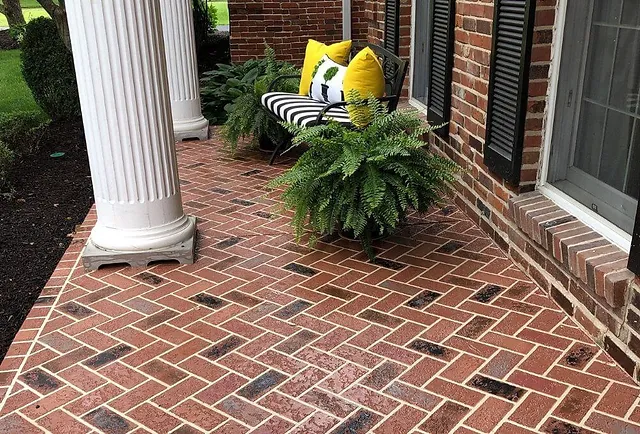When it comes to enhancing the aesthetic appeal and functionality of outdoor spaces, few materials offer the versatility and beauty of stamped concrete. Often referred to as the “artistic cousin” of traditional concrete, stamped concrete opens up a world of design possibilities, allowing homeowners to create stunning surfaces that mimic the look of natural stone, brick, or even wood. In this blog post, we’ll explore the artistry behind stamped concrete and how it can be used to transform your outdoor space into a captivating oasis.
The Beauty of Stamped Concrete
Stamped concrete is a unique material that combines the strength and durability of concrete with the aesthetic appeal of various patterns, textures, and colors. Unlike traditional concrete, which is typically poured and left plain, stamped concrete is imprinted with patterns and textures while it’s still in its plastic state, allowing for endless customization options. From intricate cobblestone patterns to rustic wood plank textures, the beauty of stamped concrete lies in its ability to replicate the look and feel of natural materials with remarkable accuracy.
Design Options and Inspiration
One of the most exciting aspects of working with stamped concrete is the sheer variety of design options available. Whether you’re looking to create a sleek modern patio or a charming cobblestone pathway, there’s a stamped concrete pattern to suit every style and aesthetic preference. Some popular design options include:
- Ashlar Slate: This pattern mimics the natural texture and irregular shape of slate stone, creating a sophisticated and timeless look.
- Herringbone Brick: For a classic and elegant feel, consider opting for a herringbone brick pattern, which adds visual interest and charm to any outdoor space.
- Random Stone: Ideal for creating a rustic and natural-looking surface, the random stone pattern features irregular shapes and textures that mimic the appearance of natural stone.
- Wood Plank: If you love the look of wood but prefer the durability of concrete, a wood plank-stamped concrete surface is a perfect choice. This pattern replicates the appearance of wood grain, complete with knots and imperfections, for a truly authentic look.
To find inspiration for your stamped concrete project, consider browsing design magazines, websites, and social media platforms like Pinterest or Instagram. Additionally, many reputable stamped concrete contractors offer galleries of past projects on their websites, providing a valuable source of inspiration for homeowners.
Benefits of Stamped Concrete
In addition to its aesthetic appeal, stamped concrete by Panorama Concrete offers a range of practical benefits that make it an attractive choice for outdoor surfaces. Some of the key benefits include:
- Durability: Stamped concrete is incredibly durable and can withstand heavy foot traffic, harsh weather conditions, and regular wear and tear.
- Low Maintenance: Unlike natural stone or wood surfaces, stamped concrete requires minimal maintenance to keep it looking its best. Regular sweeping and occasional pressure washing are typically all that’s needed to keep stamped concrete surfaces clean and well-maintained.
- Cost-Effectiveness: Stamped concrete is often more affordable than natural stone or brick, making it a cost-effective option for homeowners looking to enhance their outdoor spaces without breaking the bank.
- Customization: With stamped concrete, the design possibilities are virtually limitless. Whether you’re looking to create a bold geometric pattern or a subtly textured surface, stamped concrete can be customized to suit your unique vision and style.
Planning and Installation Process
Before embarking on a stamped concrete project, it’s essential to carefully plan and prepare for the installation process. This typically involves several key steps, including:
- Site Preparation: The first step in any stamped concrete project is to prepare the site by clearing away any debris, vegetation, or existing surfaces. This may involve excavation, grading, and compacting the soil to create a stable base for the concrete.
- Concrete Mixing and Pouring: Once the site has been prepared, the next step is to mix and pour the concrete. This is typically done using a concrete mixer and pump, which allows for precise control over the consistency and placement of the concrete.
- Stamping and Texturing: Once the concrete has been poured, it’s time to stamp and texture the surface. This is typically done using specialized stamping mats or rollers, which are pressed into the surface of the concrete to create the desired pattern and texture.
- Curing and Sealing: Finally, the stamped concrete surface is allowed to cure for a while before being sealed to protect it from stains, water damage, and UV exposure. This typically involves applying a high-quality concrete sealer, which helps to enhance the color and texture of the concrete while providing long-lasting protection against the elements.
Maintenance Tips for Stamped Concrete
While stamped concrete is relatively low-maintenance compared to other outdoor surfaces, it’s still essential to take proper care of it to ensure its longevity and beauty. Some essential maintenance tips to keep in mind include:
- Regular Cleaning: To keep stamped concrete surfaces looking their best, it’s essential to sweep or rinse them regularly to remove dirt, debris, and other contaminants.
- Sealing: Depending on the climate and level of foot traffic, stamped concrete surfaces may need to be resealed every few years to maintain their appearance and protect them from damage.
- Repairing Cracks and Damage: Over time, stamped concrete surfaces may develop cracks or other signs of wear and tear. It’s essential to address these issues promptly to prevent them from worsening and compromising the integrity of the surface.
- Avoiding Harsh Chemicals: When cleaning stamped concrete surfaces, it’s essential to avoid using harsh chemicals or abrasive cleaners, as these can damage the sealer and cause discoloration or staining.
By following these maintenance tips, homeowners can ensure that their stamped concrete surfaces remain beautiful and functional for years to come.
Conclusion
Stamped concrete offers a unique combination of beauty, durability, and versatility that makes it an ideal choice for transforming outdoor spaces. Whether you’re looking to create a stunning patio, driveway, walkway, or pool deck, stamped concrete can help you achieve your vision with style and elegance. By understanding the design options, benefits, planning process, and maintenance requirements outlined in this blog post, you’ll be well-equipped to embark on your own stamped concrete journey and create an outdoor space that truly reflects your personality and lifestyle.




